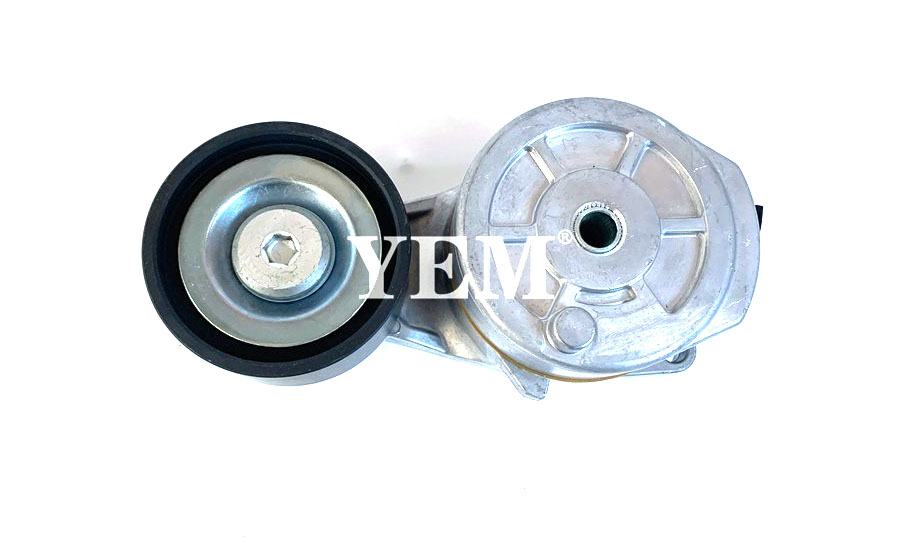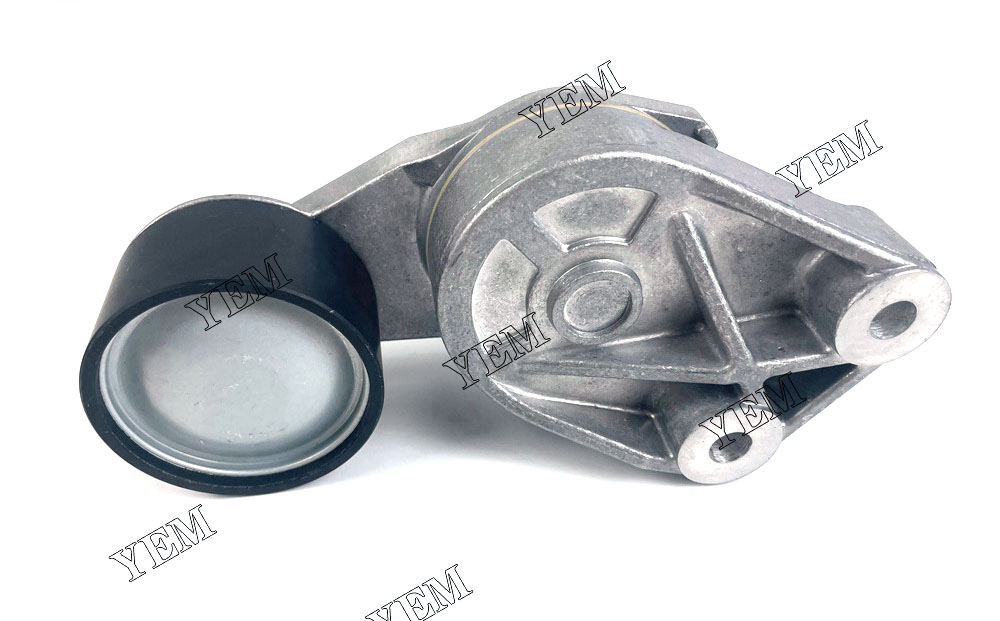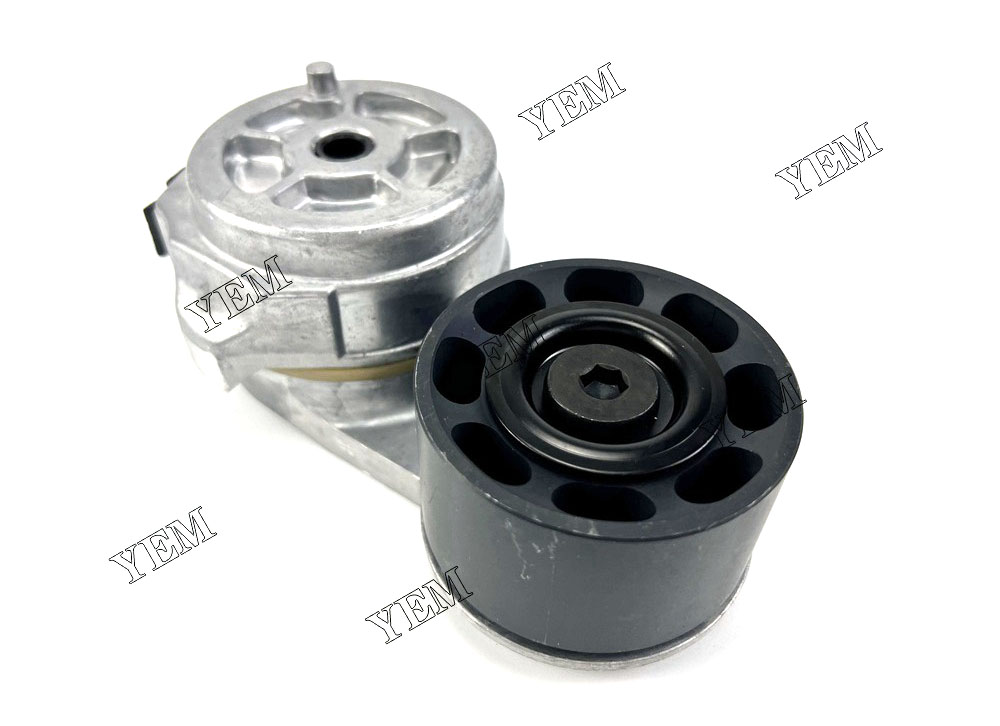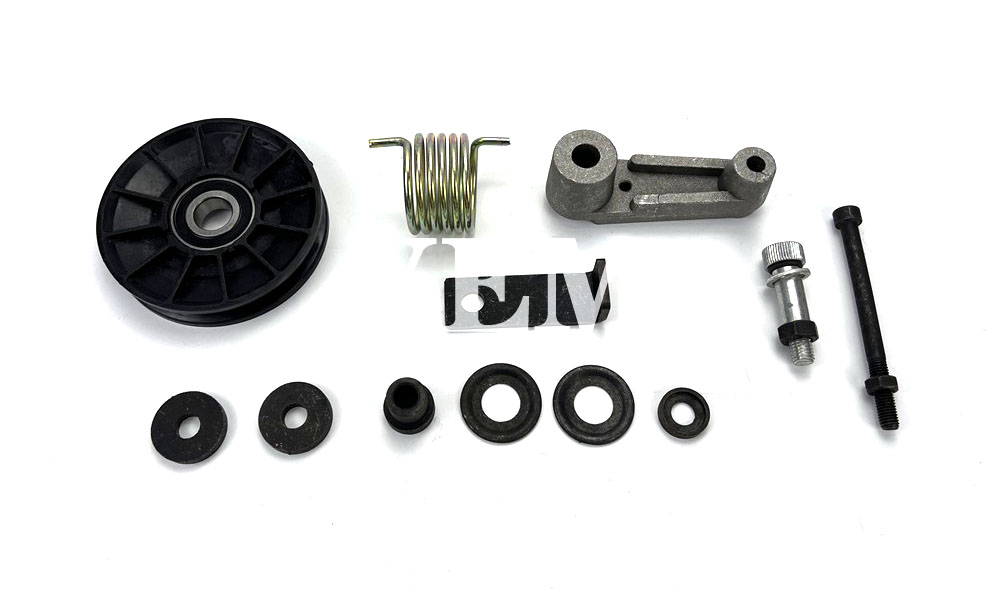The function of belt tensioner
The main function of the belt tensioner in the engine system is to maintain the correct tension of the belt. It adjusts and maintains the tightness of the belt so that the belt can effectively transmit power and drive the auxiliary equipment of the engine, such as generators, water pumps, air-conditioning compressors, etc.
The following are the main functions of the belt tensioner:
- Maintain the correct tension: The belt tensioner can automatically adjust the tension of the belt and keep it within an appropriate range. This ensures that the belt does not work too loose or too tight, thereby maximizing the transmission efficiency of the belt and reducing energy loss and engine load due to improper tension.
- Reduce noise and vibration: When the belt is loose or too tight, it will cause noise and vibration. The belt tensioner adjusts the tension of the belt and maintains an appropriate tension state, which can reduce the generation of vibration and noise, improve the comfort of the driver and the working stability of the engine.
- Extend the life of the belt: Too loose or too tight a belt will lead to increased wear of the belt and reduce its service life. The belt tensioner can ensure that the belt runs in the correct tension range, reduce friction and wear, prolong the service life of the belt, and reduce the frequency of maintenance and replacement.
- Protect other transmission components: too loose belts are prone to slipping, while too tight belts will bring excessive load to the transmission components. The role of the belt tensioner is to ensure the proper tension of the belt, avoid excessive or small loads from causing damage to the transmission system, and protect the safety and reliability of other key components.
To sum up, the role of the belt tensioner is to ensure the normal operation of the belt drive of the engine system, improve the efficiency and reliability of the engine, and reduce failure and maintenance costs.

The structure and working principle of the belt tensioner
A belt tensioner is a common mechanical device used to maintain the correct tension and transmission efficiency of a belt system. It usually consists of a shaft, a tensioner and a tensioning device.
Structure: The belt tensioner is usually mounted on a mechanical device by a fixed shaft, and the tensioner is fixed on the shaft and can rotate freely. Tensioners typically have raised teeth or grooves on the outside surface to make contact with the belt and provide better friction.
How it works: When the belt system starts running, the tensioner applies force to the tensioner pulley, pushing it against the belt. In this way, the contact area between the tensioner pulley and the belt forms a friction force. The presence of friction serves two main purposes:
- Maintain the correct tension: By adjusting the position of the tensioner, the belt can be maintained at an appropriate tension. This helps prevent the belt from slipping or failing during transmission.
- Provides power transmission: The friction created by the contact between the friction of the tensioner pulley and the belt helps to transmit power. When the tensioner pulley is pushed against the belt, friction transfers power to the belt, which drives the corresponding mechanical part.
It should be noted that belt tensioners can also be equipped with self-adjusting features to cope with stress, wear or changing operating conditions. This ensures that the belt system always maintains the proper tension under different loads and speeds, thus improving transmission efficiency and extending service life.
Belt tensioner failure and maintenance
The failure of the belt tensioner may involve the following aspects:
- Insufficient or excessive tension: If the tension of the belt tensioner is insufficient, the belt may slack, resulting in reduced transmission efficiency or even falling off. Excessive tension can place an excessive load on the belt, causing premature wear or breakage.
- Tensioner bearing failure: The bearing inside the belt tensioner may be worn or damaged after long-term use, resulting in a decrease in the ability of the tensioner to rotate freely, which in turn affects the normal operation of the belt.
- Abrasion on the outer surface of the tensioner wheel: The protruding teeth or grooves on the outer surface of the tensioner wheel are used to provide friction, but long-term friction and wear will cause the surface to become flat or lose friction, which will affect the tension between the belt and the belt. The force transmission effect between the wheels.
For belt tensioner maintenance, the following are some common measures:
- Regularly check and adjust the tension: ensure that the tension of the belt tensioner is within an appropriate range to avoid transmission failure and excessive wear. Perform periodic maintenance and adjustments according to the equipment operating manual or manufacturer’s recommendations.
- Observe and clean the surface: Regularly check the wear of the surface of the tensioner, and replace the tensioner in time if wear or loss of friction is found. At the same time, regularly clean the surface of the tensioner and the belt contact area to remove dust and dirt.
- Check the condition of the bearings: regularly check the wear of the tensioner bearings, and pay attention to whether there are abnormal noises, looseness or poor lubrication of the bearings. If necessary, replace the bearing in time to ensure the normal rotation of the tensioner.
- Pay attention to the use environment and working conditions: Try to avoid exposing the tensioner to humid, corrosive or high temperature environments, these factors may cause damage and faster wear of the tensioner.

Please note that the above are only basic reference suggestions, and the specific maintenance methods and cycles may vary depending on the type of equipment, usage conditions and manufacturer’s recommendations. Therefore, be sure to refer to the operating manual of the relevant equipment or consult a professional technician before performing any maintenance.
Things to note when purchasing and replacing belt tensioners
When purchasing and replacing a belt tensioner, there are several considerations to consider:
- Specification and model matching: ensure that the selected belt tensioner matches the specification and model of the original equipment or system. This includes wheel diameter, axle bore size, tensioner type, etc. Refer to the equipment’s operating manual or consult the manufacturer for correct specifications.
- Quality and brand reputation: Choose a belt tensioner with good quality and a reliable brand reputation. This will ensure its durability and reliability, reducing the risk of failure and repairs in long-term use.
- Material selection: Select the appropriate material according to the specific application requirements. Common tensioner materials include steel, cast iron, aluminum alloy, etc. Different materials have different strength, wear resistance and corrosion resistance, so they need to be selected according to the working environment and stress conditions.
- Regular replacement: Belt tensioners are moving parts that wear out over time, so regular replacement is necessary. Establish replacement intervals according to the equipment operating manual or manufacturer’s recommendations. Regularly check the wear degree of the tensioner and replace it when the wear reaches a certain level to ensure the normal operation of the system.
- Professional installation: When replacing the belt tensioner, it is best to have it installed by experienced technicians or professional maintenance personnel. Ensure proper installation location, measurements and adjustments to ensure accurate operation of the belt tensioner in the system.
In conclusion, before purchasing and replacing a belt tensioner, it is best to understand the requirements of the equipment and the manufacturer’s recommendations. And make sure to choose products with appropriate specifications and reliable quality, and install and adjust them through professionals to ensure the normal operation of the system and prolong its service life.
Optimization and improvement of belt tensioner
In terms of optimization and improvement of belt tensioner, the following aspects can be considered:
- Material selection: choose high-strength, wear-resistant and corrosion-resistant materials, such as high-grade alloy steel or special alloy materials. This increases the service life and durability of the tensioner.
- Reduce energy loss: By reducing the friction loss between the tensioner pulley and the belt, the transmission efficiency is improved. Use low-friction materials or surface treatments, such as coatings or hydrophobic treatments, to reduce energy loss and heat generation.
- Tension force control: An automatic adjustment system is introduced to monitor and adjust the tension of the tension pulley in real time. This can dynamically adjust the tension force according to load changes, working conditions and time factors, providing a more accurate and stable transmission effect.
- Structural optimization: reduce noise, vibration and vibration by optimizing the structural design of the tensioner. Consider using vibration-absorbing materials or adjusting the brake position to improve the stability and smoothness of the system.
- Intelligent monitoring system: use sensors and monitoring technology to monitor the running status of the tensioner in real time. Through data analysis, potential faults can be found, and early warning and maintenance can be carried out to reduce downtime and repair costs.
- Green design: pay attention to environmental impact, choose sustainable materials and manufacturing processes. Considering resource conservation, energy efficiency and environmental friendliness, we are committed to reducing our impact on the environment.

It should be noted that optimizing and improving the tensioner requires comprehensive consideration of multiple factors, such as application environment, workload, cost-effectiveness, etc. It is best to consult professionals for on-site testing and verification to ensure the effectiveness and feasibility of the improvement plan.
Common problem
When it comes to frequently asked questions about belt tensioners, here are some common questions and answers:
- What is a belt tensioner? The belt tensioner is a device used to adjust the tension of the belt, and maintain the correct operation of the transmission by changing the tension of the belt.
- Why are belt tensioners important? Proper functioning of the belt tensioner is critical to the performance and life of the driveline. It keeps the belt working under the correct tension to ensure transmission efficiency, reduce slip and wear, and provide stable transmission performance.
- How to adjust the belt tensioner? Adjusting the tension of the belt tensioner is usually done by manual or automatic adjustment device. When adjusting manually, a tool such as a wrench or bolt is usually used to turn the adjustment. Automatic adjustment adopts spring or hydraulic device to automatically adjust the tension force according to the tension state of the belt.
- How to check the failure of the belt tensioner? Common inspection methods include observing the appearance of the belt tensioner, checking whether the tensioner is worn, cracked or deformed; checking whether the bearing of the tensioner is operating normally, whether there is abnormal noise or looseness; checking whether the tension of the tensioner is Meet specification requirements.
- When should the belt tensioner be replaced? Usually, the replacement cycle of the belt tensioner depends on the use environment, workload and the degree of wear of the tensioner. If the tensioner surface is severely worn, the tension cannot be adjusted, or there are other signs of failure, you should consider replacing the tensioner.
- What are the maintenance precautions for the belt tensioner? Regularly check the tensioner for wear, tension and bearing condition. Keep the tensioner surface clean and remove dust and dirt regularly. Follow the equipment manufacturer’s instructions for maintaining and adjusting the tension of the tensioner pulley.

Note that specific questions and answers may vary by application environment and device type. For specific questions and requirements, it is recommended to refer to the equipment operation manual or consult a professional technician.
Contact us
Thank you for contacting our YEM team. We are committed to delivering outstanding service and support to our valued customers. If you have any questions or require assistance, please do not hesitate to reach out to us using any of the following contact methods:
We assure you that we are here to help and are dedicated to resolving any inquiries you may have.
